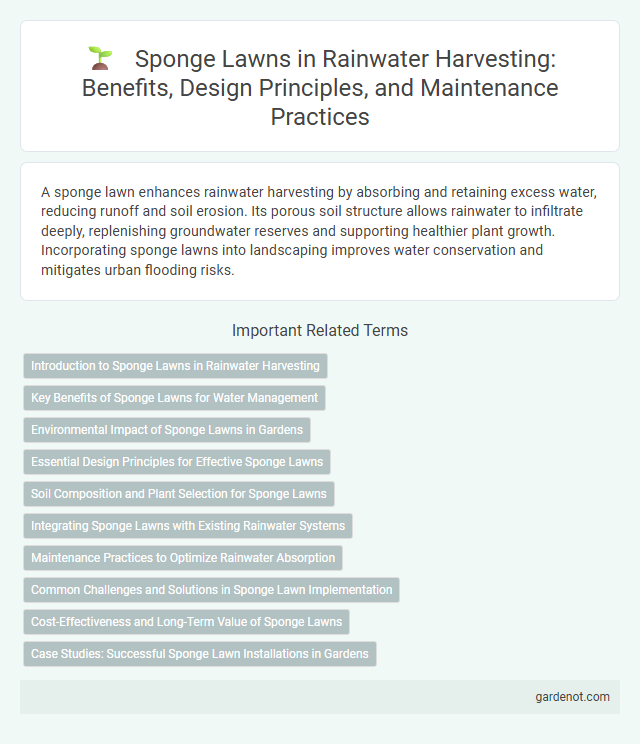A sponge lawn enhances rainwater harvesting by absorbing and retaining excess water, reducing runoff and soil erosion. Its porous soil structure allows rainwater to infiltrate deeply, replenishing groundwater reserves and supporting healthier plant growth. Incorporating sponge lawns into landscaping improves water conservation and mitigates urban flooding risks.
Introduction to Sponge Lawns in Rainwater Harvesting
Sponge lawns are specially designed landscapes that absorb and retain rainwater, enhancing groundwater recharge and reducing runoff. These lawns incorporate water-permeable soil layers and deep-rooted grasses to maximize water infiltration and minimize evaporation. Integrating sponge lawns into rainwater harvesting systems improves urban water management by naturally filtering and storing rainwater.
Key Benefits of Sponge Lawns for Water Management
Sponge lawns enhance rainwater harvesting by increasing soil infiltration and reducing surface runoff, which mitigates flood risks and replenishes groundwater. The porous structure of the soil in sponge lawns promotes natural filtration, improving water quality by trapping pollutants and sediments. These lawns also support drought resilience by retaining moisture longer, reducing irrigation needs and conserving water resources.
Environmental Impact of Sponge Lawns in Gardens
Sponge lawns significantly reduce urban runoff by enhancing soil permeability, allowing rainwater to infiltrate and recharge groundwater supplies. These permeable surfaces mitigate flooding risks and decrease the pollution of waterways by filtering contaminants before they enter storm drains. Implementing sponge lawns promotes sustainable water management and supports local ecosystems by maintaining natural hydrological cycles.
Essential Design Principles for Effective Sponge Lawns
Sponge lawns optimize rainwater absorption through permeable soil layers and deep-rooted grasses, enhancing groundwater recharge and reducing surface runoff. Effective design incorporates graded slopes for controlled water flow, organic-rich substrates to improve water retention, and strategically placed infiltration zones for maximum capture. Maintaining soil porosity and integrating native plant species further support the lawn's capacity to act as a resilient rainwater sponge in urban environments.
Soil Composition and Plant Selection for Sponge Lawns
Sponge lawns rely on well-structured soil with high organic matter content and sandy loam texture to maximize water infiltration and retention during rainwater harvesting. Selecting drought-tolerant, deep-rooted grasses such as buffalo grass or fine fescue enhances the lawn's ability to absorb and slowly release rainwater, reducing runoff and promoting groundwater recharge. Tailored soil amendments combined with native plant species optimize sponge lawn performance for sustainable urban water management.
Integrating Sponge Lawns with Existing Rainwater Systems
Integrating sponge lawns with existing rainwater systems enhances urban water management by increasing infiltration and reducing runoff. Sponge lawns are designed with permeable soil and vegetation that absorb and filter rainwater, complementing traditional rainwater harvesting infrastructure. This combination improves groundwater recharge, mitigates flooding risks, and supports sustainable water cycle management in urban environments.
Maintenance Practices to Optimize Rainwater Absorption
Sponge lawns require regular aeration to prevent soil compaction, enhancing rainwater infiltration and absorption. Maintaining proper mowing height and removing debris ensures healthy grass growth, which improves soil structure for optimal water retention. Periodic application of organic mulch supports moisture conservation and promotes microbial activity essential for efficient rainwater harvesting.
Common Challenges and Solutions in Sponge Lawn Implementation
Sponge lawn implementation faces common challenges such as soil compaction, inadequate drainage, and maintenance difficulties that hinder effective rainwater absorption. Solutions include using aeration techniques to reduce soil compaction, integrating permeable substrates to improve water infiltration, and establishing routine maintenance protocols to prevent clogging and ensure longevity. Optimizing these factors enhances the performance of sponge lawns in urban rainwater harvesting systems.
Cost-Effectiveness and Long-Term Value of Sponge Lawns
Sponge lawns offer a cost-effective solution for rainwater harvesting by reducing the need for expensive irrigation and minimizing stormwater management costs. Their porous, absorbent soil structure enhances groundwater recharge, cutting down water bills over time. Long-term value is realized through improved soil health, reduced erosion, and increased resilience to drought, making sponge lawns a sustainable investment for residential and commercial landscapes.
Case Studies: Successful Sponge Lawn Installations in Gardens
Sponge lawn installations in gardens have demonstrated significant improvements in rainwater absorption and reduction of surface runoff, as evidenced by case studies in urban areas like Singapore and Melbourne. These installations utilize permeable soil layers combined with resilient grass species to enhance groundwater recharge and mitigate flooding risks. Data from these projects reveal up to a 40% increase in rainwater infiltration compared to conventional lawns, promoting sustainable landscape management.
Sponge lawn Infographic

 gardenot.com
gardenot.com